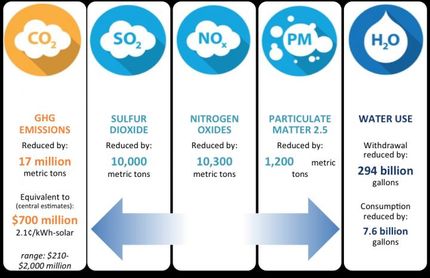New approach improves efficiency of solar cells
Advertisement
An international team of scientists, led by researchers from the Universities of York and St Andrews, has developed a new method to increase the efficiency of solar cells.
The new approach achieves highly efficient broad-band light trapping in thin films, with more light captured in the film in order to maximise absorption and electricity generation.
The research is reported in Nature Communications.
The new method builds on research into a class of materials known as quasi-crystals, which offer advantages in terms of the spectrum of light they are able to capture. However, the problem with these structures is that their properties are difficult to tailor towards specific applications as they lack the design tools available with periodic structures such as regular gratings.
To solve this problem, the researchers created a new structure called a quasi-random structure, which combines the rich spatial frequencies associated with quasi-crystals with the high level of control afforded by periodic structures.
Corresponding author Emiliano Martins, from the School of Physics and Astronomy, University of St Andrews, said: "The control of propagating light is a crucial aspect in photonics. Here, we demonstrate that by a careful design of their Fourier spectra, quasi-random nanostructures can achieve such control very efficiently."
Emiliano Martins developed the idea of the quasi-random structure with Dr Thomas F Krauss, an Anniversary Professor in the Department of Physics at the University of York.
Dr Krauss said: "Applying our nanophotonics design ideas to such an important area as solar cells is essential for improving the competitiveness of renewable energy generation."
Calculations for the research into quasi-random cells were conducted by collaborators in China.
Corresponding author Dr Juntao Li, from the State Key Laboratory of Optoelectronic Materials and Technology, Sun Yat-sen University, China, said: "Other than solar cells, our design can also be used in many light trapping areas, like LED and DFB lasers."
Most read news
Topics
Organizations
Other news from the department science

Get the chemical industry in your inbox
By submitting this form you agree that LUMITOS AG will send you the newsletter(s) selected above by email. Your data will not be passed on to third parties. Your data will be stored and processed in accordance with our data protection regulations. LUMITOS may contact you by email for the purpose of advertising or market and opinion surveys. You can revoke your consent at any time without giving reasons to LUMITOS AG, Ernst-Augustin-Str. 2, 12489 Berlin, Germany or by e-mail at revoke@lumitos.com with effect for the future. In addition, each email contains a link to unsubscribe from the corresponding newsletter.































































